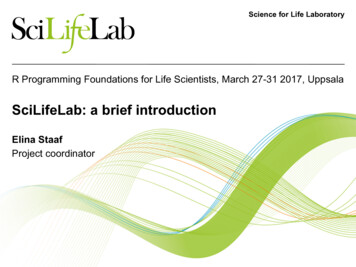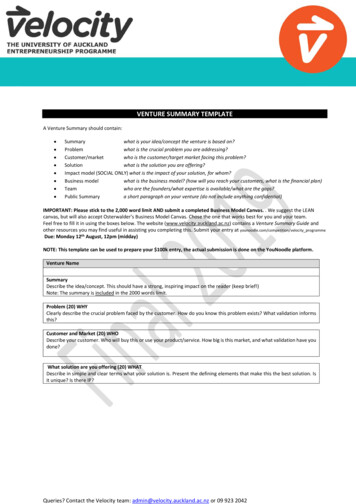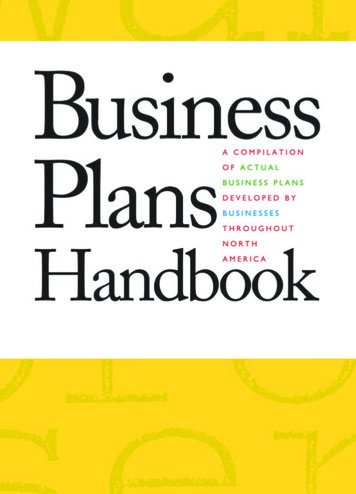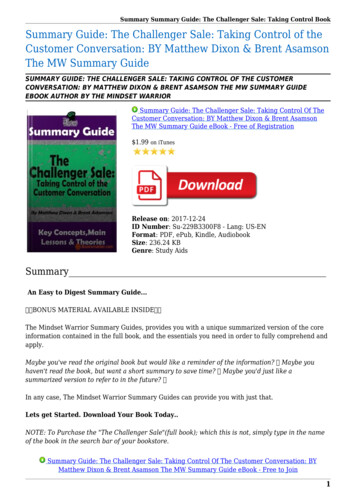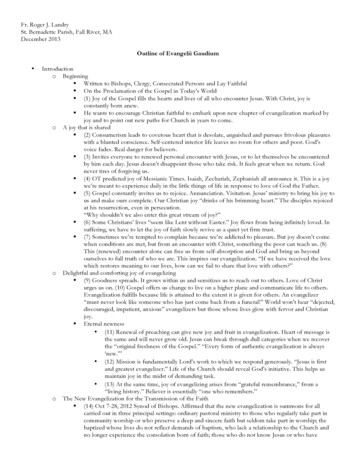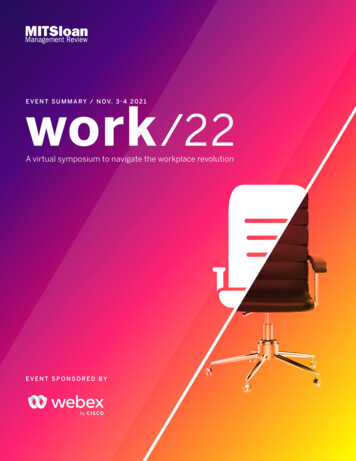
Transcription
tkwork/22E V E N T S U M M A R Y / N O V. 3 - 4 2 0 2 1A virtual symposium to navigate the workplace revolutionEVENT SPONSORED BYWo r k /2 2 M I T S l oa n M a n ag e m e n t R e v i e w1
C ON T EN T S1Recapping Work/22Abbie Lundberg and Elizabeth Heichler, MIT Sloan Management Review2Sponsor’s Introduction: Hybrid Work Is the FutureAruna Ravichandran, CMO, WebEx Collaboration, Cisco3Leading in an Era of Employee ActivismMegan Reitz, Hult International Business School5A Chief People Officer’s View of the Future of WorkJacqui Canney, ServiceNow7DEI Practices That Have an ImpactStephanie Creary, Wharton School of the University of Pennsylvania9Agility at the Point of ExecutionRob Cross, Babson College11A Global Brand President’s View of the Future of WorkDoug Palladini, Vans13Creating Good JobsZeynep Ton, MIT Sloan School of Management15A Leader’s Guide to Hybrid-Remote Work SuccessTsedal Neeley, Harvard Business School17Effective Coaching, Mentoring, and Sponsorship inthe Virtual OfficeCurtis Odom, Northeastern UniversityWo r k /2 2 M I T S l oa n M a n ag e m e n t R e v i e wi
I n t r o d u cti o nRecapping Work/22Thank you for attending Work/22, our two-day virtual symposium to help leaders anticipatethe challenges they will face in the year ahead — what we’re calling Post-Pandemic Year One.Our guests, who joined us for presentations and fireside chats, showcased new research andinsights into what the workplace will look like after the past two tumultuous years. We lovedtheir sense of optimism and possibility about what the future can be if we manage it well.On our first day, Megan Reitz discussed how to manage in an era of employee activism; JacquiCanney dived into the intersection of people, technology, and inclusion; Stephanie Crearyshared new research into how companies are combining strategies for targeted DEI outcomes;and Rob Cross explained how to identify collaborative dysfunction — and then improve it.On our second day, Doug Palladini talked about all the ways that the future of work is playingout at his company, Vans; Zeynep Ton explored why we have so many bad jobs when goodjobs are better for companies, and what an alternate system requires; Tsedal Neeley detailedthe leadership challenges for working with employees who are not just remote but isolated —and looking for connection; and Curtis Odom closed out our program by presenting ways todevelop coaching, mentoring, and sponsorship in the new workplace.We convened this roster of great thinkers to help you get started. There’s no question that workwill be very different five to 10 years from now. The decisions and actions that we all take in2022 can lead to a future that works better for everyone.All of the issues we covered during Work/22 are evolving. MIT Sloan Management Reviewwill continue to bring you the latest thinking and advice on leading, inspiring, and growing aworkforce that is equipped to tackle tomorrow’s challenges. We’re committed to being yourbest source of powerful ideas that can make a real difference to your organization.Abbie LundbergEditor in Chief,MIT Sloan Management Review@abbielundbergWo r k /2 2 M I T S l oa n M a n ag e m e n t R e v i e wElizabeth HeichlerExecutive Editor,MIT Sloan Management Review@eheichler1
S p o n s o r’s I n t r o d u cti o nHybrid Work Is the FutureThe Work/22 event recognized that the past 18 months of global disruption have createdpressing new challenges for leaders.A recent study conducted by Cisco examined how people’s habits and technology interactionsduring the COVID-19 pandemic have permanently reshaped work. It found that workers expectgreater flexibility: Sixty-four percent agreed that the ability to work remotely instead of cominginto an office would directly affect whether they would stay at or leave a job. As many companiestransition to a hybrid work model, we have an unprecedented opportunity to create workplacesthat support greater inclusivity and ensure that remote workers won’t be left behind.We know that humans are wired to prefer in-person interactions, and in-office employees couldpotentially get more attention — and more promotions — than their remote counterparts.Leaders must focus on what it will take to create a company culture that can unlock humanpotential, whether employees work in the office or at home. We believe that leaders mustensure that they enable hybrid work arrangements that are flexible, inclusive, and supportive,and that the tools provided are secure and well managed.Organizations have a unique opportunity to rethink their approaches to work and culture.Getting it right means more engaged and energized employees, better productivity, higheremployee retention, and, ultimately, better company performance. I hope the insights sharedby the Work/22 speakers here will help you retain and attract talent and engage employees incocreating a new future of work that works for everyone.Aruna RavichandranVice President and Chief Marketing Officer ofCisco Webex/Collaboration@aruna13Wo r k /2 2 M I T S l oa n M a n ag e m e n t R e v i e w2
Leading in an Era ofEmployee ActivismMegan Reitz, Hult International Business SchoolRising generations of employees are demanding thatleaders engage on topics such as climate change and racialequity, and leaders must understand how to respond. How canorganizations develop a plan for encouraging employee voice andacting on issues raised by workers?S u mm a ryMegan Reitz and her research partner, John Higgins, have spent seven years exploring theexperience of speaking truth to power in organizations — what gets said and what doesn’t,and who gets heard and who doesn’t. She has observed activists who are seeking toinfluence their organizations’ policies on wider social and environmental issues and foundthat the process is upsetting the power dynamics: When it comes to activism, leaders arenot in control, and they often don’t know the answer.Her first point: The word activism brings specific images and judgments to mind. In somecountries and on some issues, it’s cool to be labeled an activist; in other areas and topics,it’s life-threatening. Activism is in the eye of the beholder; as author Ruchika Tulshyan hassaid, “What looks like rebellion to you might be another’s human fundamental right.” All ofthis matters because leaders will take actions driven in part by their assumptions aboutthis loaded term.Her second point: As leaders become more senior level, they become more optimistic.Younger employees might say that those leaders are more deluded: They overestimatehow well they listen to employees, and they’re often taken by surprise because of thebubble of optimism they live in.In the past, leaders would say, “We’re neutral. We’re apolitical.” Reitz says that doesn’t cutit anymore: “What we’re discovering is that that excuse is getting pretty difficult to say now.You can’t sit on the activism fence. Inaction is as political as action.” Leaders don’t have tobe engaged on every issue, but they do have to show curiosity about understanding more.They need to invest some humanity and some relationship capital in that process. Howleaders make their choices matters.Reitz uses a taxonomy to describe how leaders react to activist overtures, ranging fromnon-engagement to full engagement. Leaders fall into one of three stages around activistdemands, she said: defensive engagement, dialogic engagement (where they concede thatthey don’t know the answers but start listening and sharing decision-making), and activistWo r k /2 2 M I T S l oa n M a n ag e m e n t R e v i e w3
engagement. Leaders in the last stage, such as those at Ben & Jerry’s and Patagonia,vigorously encourage activism by their employees.Reitz noted that if a leader isn’t hearing any activist voices, that doesn’t mean there aren’tany. It could mean that there’s a perception that the organization doesn’t have the ability totolerate difference — something that will hurt the company in the long run.Ta k e Aways Leaders often live in an optimism bubble, overestimating their listening skills andunderestimating others’ silence. Leaders’ responses to activism have consequences. The first step in engaging with employee activists is examining what assumptions theterm activist conjures up.A B OU T T H E S p e a k e rMegan Reitz is a professor of leadership and dialogue at Hult International BusinessSchool. Her research explores the intersection of leadership, change, dialogue, andmindfulness. Her latest book is Speak Up (FT Press, 2019), and her article “Leading in anAge of Employee Activism,” coauthored with John Higgins, will appear in an upcomingissue of MIT Sloan Management Review.Wo r k /2 2 M I T S l oa n M a n ag e m e n t R e v i e w4
A Chief People Officer’s Viewof the Future of WorkJacqui Canney, ServiceNowThe intersection of people and technology has createdimmense opportunities for businesses and new challengesfor managers to lead an increasingly diverse and distributedworkforce. Inclusion is the key skill for the future of work, andmanagers must be equipped to lead in an inclusive way.S U M M ARYWhat does it take to create a sense of culture, inclusion, and belonging in the hybridwork environment?Jacqui Canney noted that although she has been at ServiceNow for just a few months,already she sees that — because of “the Great Resignation” or “the Great Shuffle” — thewar for talent has never been more intense. ServiceNow has hired 5,000 people in the pastyear and is looking to double the size of the company; that means that “the people whowork here are in the driver’s seat,” Canney said.Building an inclusive culture, where employees feel a deep sense of belonging, is a toppriority. “This is very much table stakes,” she said. The company wants to make peoplefeel safe and welcome, and also cherished.“We are in a once-in-a-generation moment,” Canney said. This means putting employeesat the center of the development of the technology they use to do their jobs. Too often,she says, companies think about technology’s capabilities first rather than how people willinteract with it. Instead, the key question is, “How do we build experiences for our peoplethat are consumer grade?” Part of her answer involves working closely with ServiceNow’sCIO “so [IT’s] tech road map and our people strategy are aligned.”Technology, she continued, can be an enabler or get in the way. Companies have todevelop in-house applications “just the way Apple ships a phone.” That means conductinguser experience testing to make sure the employee experience is solid. This, she said, isthe future of HR work.Canney said that she won’t start meetings unless everyone is able to participate. And ifthere are technology problems, she waits. “We’ve lost the first 30 minutes of a meeting,”she said, but “my job has been making sure people feel like they get to interject, have avoice.” It’s a challenge that takes practice, she acknowledged.Wo r k /2 2 M I T S l oa n M a n ag e m e n t R e v i e w5
Canney also talked about how to handle working in crisis mode. She described workinglong hours in her basement for her previous employer at the start of the pandemic andrealizing that it was unsustainable — for both herself and her staff. Her solution was tomove employees into three categories: people who were working on the crisis, people whowere working on the stable parts of the business that were ongoing, and people who weretasked to look toward the future and determine how to grow the business.TAKEAWAYS Workplaces need to be safe, empathetic, and compassionate. Authentic conversationsare necessary, even when conducted via videoconferencing. The technology used by employees for everyday work must be of consumer-level quality. Crises can be managed at the people level by tasking some employees to work on thecrisis and others to work on the basic business.A B OU T T H E S PEAKERJacqui Canney is chief people officer for ServiceNow. She leads talent strategies for thecompany’s rapidly growing global workforce of more than 14,000 employees. Prior tojoining ServiceNow, Canney served as the global chief people officer for WPP, a creativecompany with over 100,000 full-time employees and nearly five times that manycontractors and freelancers. Before that, she held a similar role at Walmart.Wo r k /2 2 M I T S l oa n M a n ag e m e n t R e v i e w6
DEI Practices That Havean ImpactStephanie Creary, Wharton School of the University of PennsylvaniaMany organizations have recently renewed and strengthenedtheir commitments to diversity, equity, and inclusion in theworkplace, but management often lacks clarity on what specificpractices will make an impact. Creary coauthored a large-scaleresearch study that shows what practices really underlie positiveDEI outcomes, and she shared them in her session.S u mm a ryStephanie Creary’s research is driven by an attempt to understand efforts arounddiversity, equity, and inclusion (DEI) through their potential for good. Positive outcomesfrom DEI, she says, include employees feeling that they are known and understood forwho they are, and that they’re developing allied relationships in the workplace. “We havedecades of research saying how fraught diversity, equity, and inclusion can be,” she noted.“How do we change that?”A May 2021 research report she coauthored at Wharton, “Improving Workplace CultureThrough Evidence-Based Diversity, Equity and Inclusion Practices,” describes evidencebased insights that identify which specific actions lead to which kinds of changes.“When we talk about evidence-based diversity, equity, and inclusion practices, we’re usingsimilar language that they use in the field of medicine,” Creary said. “If you have medicinesitting in a medicine cabinet, you don’t just take it randomly for any problem that you have.You pick medicine that’s designed to address the specific needs that you have.” In thesame way, she set out to map DEI practices onto outcomes.Creary said that she has heard “so many dehumanizing things” about middle managementand DEI — specifically, that managers present roadblocks and obstacles to efforts. Instead,she said, think of middle managers as people who have a lot of work to do, and considerthat the company might have to do a better job of meeting them where they are. “How dowe begin to translate all of the opportunities into middle manager language?” she asked.“What are specific tactics that they need to become familiar with?”Part of her work has been to identify seven practices that lead to DEI outcomes — diversityrecruiting initiatives, education and training, internal diversity partners, managerialinvolvement, mentoring and sponsorship, physical visibility, and workplace policies — andthen map them onto 12 different outcomes.Wo r k /2 2 M I T S l oa n M a n ag e m e n t R e v i e w7
She found that certain bundles of practices are more influential in driving certainoutcomes. For instance, if the goal is to create a stronger sense of belonging, bundlingthree practices (managerial involvement, mentoring and sponsorship, and workplacepolicies) are most effective. On the other hand, if the goal is to get more people to speakout against bias, the practice of education and training is critical.The point, she reiterated, is to see DEI strategy as a variety of medicines in the medicinecabinet that can best be used in certain combinations, depending on the outcomes you aremost focused on.TAKEAWAYS Tools to build DEI are like medicines: They can be used in different ways to different effect. Seven workplace practices can be mixed and matched to reach 12 DEI outcomes. Specific bundles of practices have proved to be effective at driving each of the 12 outcomes.A B OU T T H E S PEAKERStephanie Creary is an assistant professor of management at the Wharton School ofthe University of Pennsylvania and an identity and diversity scholar. She coauthored theresearch study “Improving Workplace Culture Through Evidence-Based Diversity, Equityand Inclusion Practices,” published in May 2021.Wo r k /2 2 M I T S l oa n M a n ag e m e n t R e v i e w8
Agility at the Point of ExecutionRob Cross, Babson CollegeThe collaborative intensity of work has skyrocketed, yetmost organizations don’t manage internal collaborationproductively. Collaborative dysfunction can be identifiedand improved on at the point of execution, where teams areworking on new products, on strategic initiatives, or with top clients.S u mm a ryWhat does it take to lead agile, high-functioning teams that collaborate effectively? That’sthe question Rob Cross has been exploring with his research group.Collaboration increasingly happens through networks, and these networks have startlingcharacteristics when you look at them closely. Hierarchies have collapsed thanks toemployees’ instantaneous access to one another. Many people live in a state of collaborative intensity. Cross said that 3% to 5% of people tend to account for 20% to 30% ofvalue-added collaborations — and these are the people who really matter in any collaborative mix. But they are dramatically overwhelmed, and they sometimes create pinch pointsthat slow work down and impede their own ability to get work done and be innovative.Organizations need to reduce the collaborative overload on these frequent collaborators,and they need to find more of them.Are those people replicable? They are, but with some caveats. Cross’s research found thatit takes most people about three to five years to enter an organization and replicate theconnectivity of a high performer. That involves developing the bridging relationships andreputational capital trust that will distinguish them and help them innovate differently.However, Cross’s research also found that 10% of the population manage to become highperformers not in three to five years but in about nine to 12 months. How can organizationsfoster that type of agility in order to “slingshot people into productive positions,” as Crossputs it? How can analytics be used to see the sets of connections that need to happen andfacilitate those connections?A number of factors come into play, including rapidly integrating newcomers; engagingremote workers; shaping ecosystems in which teams reside; facilitating collaboration acrosssilos where necessary; discouraging cliques that diminish alignment; reducing collaborativeoverload on the key players; and identifying and rewarding effective collaborators.Put another way: Manage the center, manage the edge, minimize silos, build agility, andminimize insularity.Wo r k /2 2 M I T S l oa n M a n ag e m e n t R e v i e w9
Managing the collaborative process better matters because people are burned out. Inan instant poll of Work/22 participants during Cross’s presentation that asked, “Whichof these patterns is the most problematic for you right now?” 37% selected “priorityoverload,” and 22% chose “overwhelmed pattern,” a scenario in which all team membersare involved in all processes and communication.The bottom line is that workplaces asking employees to adapt numerous collaborative toolsand digital architectures need a better handle on the collaborative footprint they create.TAKEAWAYS Efforts to create more agile organizations have succeeded in removing elements that getin the way of speedy decision-making. A small number of people are key collaborators, essential to many groups. Between the speed and volume of collaboration, many critical players within organizations face collaborative overload.A B OU T T H E S PEAKERRob Cross is the Edward A. Madden Professor of Global Leadership at Babson College.He is cofounder and current research director of the Connected Commons, a consortiumof over 100 organizations accelerating network research and practice. MIT SloanManagement Review published an interview with Cross, “Easing the Invisible Burdens ofCollaboration,” in September 2021.Wo r k /2 2 M I T S l oa n M a n ag e m e n t R e v i e w10
A Global Brand President’sView of the Future of WorkDoug Palladini, VansIn response to the pandemic, many companies aretransforming their workforce approaches. For global sportslifestyle brand Vans, that has included managing retail storedisruptions, developing programs to broaden accessibility intocreative brand careers, and going all-in to increase diversity andinclusion for underrepresented minorities among both full-timestaff members and the contractors and creatives who contributeto the brand.S u mm a ryLike a lot of companies, Vans has had to be flexible with its workforce during the pandemic.“These changes are permanent,” said Doug Palladini. “We’re not going back.” Listening tothe employee base, “what we’re hearing very loud and clear is they need more flexibility intheir lives. People are really enjoying taking their kids to school, being home at lunch, beingable to exercise when they feel like it, and still doing a great job at work.”Flexibility at work has been served well by asynchronous communication. That was alwaysimportant for Vans, which operates in 100 countries, but it established itself as the chosencollaboration method during the pandemic. “I’m not paid to promote Slack, but I’m a bigfan,” said Palladini. “The mentality of the meeting as this default, central way that businessgets done is very old-school and needs to go away.” Face-to-face meetings, he said, willnow happen only when there’s a clear strategic reason to get people together.His company has lost something by being run through videoconference and written notes,though. Palladini said that before COVID-19, the company’s in-person culture was palpableand effusive. Everyone could feel the energy. “When you’re on Zoom, you cannot,” he said.“It’s not the same thing.” The feeling of separation from the company culture, he said, hasbeen the biggest loss.Some actions help bridge the gap. Palladini said that leaders have “made it a practiceto never begin a conversation without making it personal” — they recognize the humanmoment before diving in. And cultural training, which used to be done at the home officein California, is done today through what Palladini called “microclimates”: local versions ofcultural immersions in Kuala Lumpur, Montreal, Shanghai, and other international bases.The company has made a big commitment over the past year to become more inclusive. Ithas published goals to increase diversity, from the athletes it works with to the full-timeWo r k /2 2 M I T S l oa n M a n ag e m e n t R e v i e w11
staff members it hires. It has also put resources toward supporting artists, musicians, andorganizations doing work around racial and gender equity.“When we took the decision to say that Black Lives Matter — which, by the way, we thinkis a pretty low bar — we knew that there were going to be people who had been fans whowere not going to agree,” Palladini said. Some customers made it clear that they wouldtake their business elsewhere, but the company didn’t blink. “Honestly, we’re good withthat,” Palladini said. “If you are unwilling to stand for what you believe in and make peopleunderstand who you are and who you are not, then you’re at greater peril than ever before.”TAKEAWAYS “The meeting” as the default way to do business is an antiquated concept. Companiesmust embrace asynchronous collaboration. Global companies need to allow for regional differences to allow customers to seethemselves in the brand. Strive for global consistency with local relevancy. Companies can no longer sit on the sidelines of social issues.A B OU T T H E S PEAKERDoug Palladini is global brand president of Vans and oversees the strategic direction of thecompany’s more than 4 billion global business. Since joining Vans in 2004, he has playedan integral role in its transformation into an icon of creative expression in youth culture andthe largest action sports footwear and apparel brand on the planet.Wo r k /2 2 M I T S l oa n M a n ag e m e n t R e v i e w12
Creating Good JobsZeynep Ton, MIT Sloan School of ManagementUnderlying the “Great Resignation” is the reality that weare not generating enough good jobs with fair pay and goodworking conditions. That’s a problem for society and alsofor companies, and company leaders must drive systemicchange. Managers need to understand why people don’t like theirjobs — and which leadership beliefs and expectations must bereexamined.S U M M ARYThe tsunami of resignations and difficulty hiring workers that has hit many industries leadsto an urgent question: How can organizational leaders create better, more desirable jobs?Zeynep Ton started her presentation by noting that most leaders would rather offer goodjobs than bad jobs — and yet millions of people have positions that offer poor pay, unpredictable schedules, and little security.Leaders lack awareness about how bad things have gotten, Ton said. Additionally, wherethere is awareness, there’s a lack of conviction to do anything about it. And where there isboth awareness and conviction, there’s a lack of courage.“I hear, ‘We already pay above-market wages,’ and, ‘Our engagement scores are high,’ and,‘Why are employees still leaving?’ I hear this over and over again,” Ton said. Companieswondering why they can’t attract job candidates need to look at the base level of whatpeople want and whether those hygiene factors are being met. Ton defined those needsas good pay and benefits, a stable and predictable schedule, a career path, and securityand safety. Only after those elements are in place can workers worry about satisfaction,belonging, and meaningfulness.Ton put wages into context. Before the pandemic, she noted, 46.5 million Americansworked in jobs that paid less than 15 an hour. This includes retail sales workers, movers,restaurant employees, home health care aides, and preschool and special educationteachers. Annualized, that pay of 31,200 is below subsistence level for most familiesacross the country.Low pay leaves workers vulnerable to a vicious cycle of poverty: It makes it difficult to meetfinancial obligations, which leads to stress and health issues, which reduces a person’sability to do a good job, which leads to high turnover and attendance issues — which leadsback to low pay.Not investing in workers creates a different kind of vicious cycle for companies, Toncontinued. “Unit managers in these companies are constantly fighting fires,” she said.Wo r k /2 2 M I T S l oa n M a n ag e m e n t R e v i e w13
“They have no time to hire the right people, because there are operational problems, thereare attendance problems, there are turnover problems.”The way out is to embrace what Ton calls the Good Jobs System. It calls for a 100%commitment to customers, employees, and improvement. Practically, it means operatingwith slack (that is, at less than full capacity), focusing and simplifying, and cross-trainingemployees. It requires a deep conviction that ordinary people can do extraordinary things.It starts with a willingness to take a dive into a pay analysis to see what percentage ofemployees are making subsistence-level wages and what the racial and gender makeup ofthose employees is.TAKEAWAYS Poor jobs are endemic, and they are a core part of why employers are finding it difficult tohire and retain workers. Companies can’t live their values if their employees can’t afford to put food on the table. Whatever your assumption about workers is, you will be proved right.A B OU T T H E S PEAKERZeynep Ton is a Professor of the Practice at the MIT Sloan School of Management. She ison a mission to develop and share knowledge on how companies can profitably offer goodjobs with living wages, stable schedules, meaning, and dignity. Ton is president of thenonprofit Good Jobs Institute and the author of The Good Jobs Strategy: How the SmartestCompanies Invest in Employees to Lower Costs and Boost Profits (Houghton MifflinHarcourt, 2014).Wo r k /2 2 M I T S l oa n M a n ag e m e n t R e v i e w14
A Leader’s Guide toHybrid-Remote Work SuccessTsedal Neeley, Harvard Business SchoolAs organizations pivot to a mix of in-person and remotework arrangements, leaders face new challenges inmaintaining trust, organizational cohesion, corporate culture, andemployee engagement. Neeley’s session examined how leaderscan be most effective in virtual or hybrid workplaces and whatnew skills they need to develop.S u mm a ry“The name of the game is adaptive and inclusive leadership,” Tsedal Neeley said. “Not justin the sense that many people talk about,” meaning diversity, equity, and inclusion, but inthe sense of making sure that remote workers are equipped and empowered to feel part ofthe team.Thirty years of scholarship has looked at how people connect with colleagues they barelysee. Much of the focus, Neeley said, has been on how to build trust. “Trust is at the heart ofeverything that we do interpersonally,” she said.Within the remote environment, she said, two types of trust are necessary: cognitive swifttrust and emotional trust. Cognitive swift trust is grounded in the degree to which virtualcollaborators feel others in the group are reliable — something that’s knowable, throughobservation or from what other people tell them — and how competent and qualified theyfeel they are. If people know both these things about each other, said Neeley, they can bevery effective remote collaborators.Emotional trust is grounded in the belief that a person cares for others — their concerns,their interests, their difficulties. This type of trust, she said, is something that “leadersmust earn.” As the saying goes, “Nobody cares how much you know, until they know howmuch you care.”Part of caring today, Neeley said, is mitigating the professional isolation that remoteworkers, especially younger ones, may be experiencing. That means checking in on,coaching, and supporting people, and making sure that there’s a strong sense of collaboration rather than one of people working ve
worEVENT SUMMARY / NOV. 3 4 2021 k . experience of speaking truth to power in organizations — what gets said and what doesn’t, . non-engagement to full engagement. Leaders fall into one of three stages around activist demands, she said: defensive engagement, dialogic

